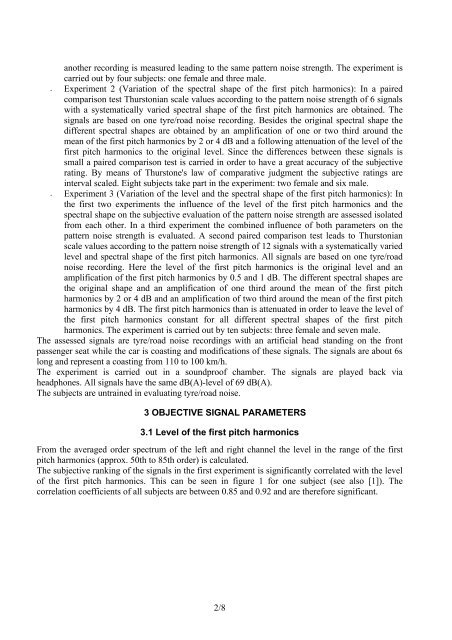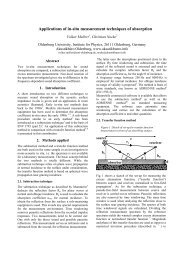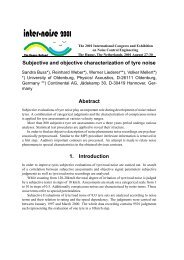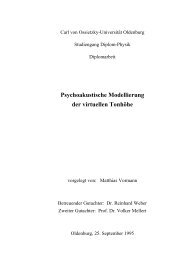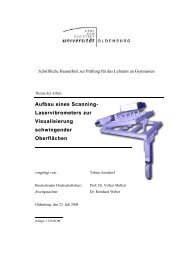Perception of tonalness of tyre/road noise and objective ... - Acoustics
Perception of tonalness of tyre/road noise and objective ... - Acoustics
Perception of tonalness of tyre/road noise and objective ... - Acoustics
Create successful ePaper yourself
Turn your PDF publications into a flip-book with our unique Google optimized e-Paper software.
another recording is measured leading to the same pattern <strong>noise</strong> strength. The experiment is<br />
carried out by four subjects: one female <strong>and</strong> three male.<br />
- Experiment 2 (Variation <strong>of</strong> the spectral shape <strong>of</strong> the first pitch harmonics): In a paired<br />
comparison test Thurstonian scale values according to the pattern <strong>noise</strong> strength <strong>of</strong> 6 signals<br />
with a systematically varied spectral shape <strong>of</strong> the first pitch harmonics are obtained. The<br />
signals are based on one <strong>tyre</strong>/<strong>road</strong> <strong>noise</strong> recording. Besides the original spectral shape the<br />
different spectral shapes are obtained by an amplification <strong>of</strong> one or two third around the<br />
mean <strong>of</strong> the first pitch harmonics by 2 or 4 dB <strong>and</strong> a following attenuation <strong>of</strong> the level <strong>of</strong> the<br />
first pitch harmonics to the original level. Since the differences between these signals is<br />
small a paired comparison test is carried in order to have a great accuracy <strong>of</strong> the subjective<br />
rating. By means <strong>of</strong> Thurstone's law <strong>of</strong> comparative judgment the subjective ratings are<br />
interval scaled. Eight subjects take part in the experiment: two female <strong>and</strong> six male.<br />
- Experiment 3 (Variation <strong>of</strong> the level <strong>and</strong> the spectral shape <strong>of</strong> the first pitch harmonics): In<br />
the first two experiments the influence <strong>of</strong> the level <strong>of</strong> the first pitch harmonics <strong>and</strong> the<br />
spectral shape on the subjective evaluation <strong>of</strong> the pattern <strong>noise</strong> strength are assessed isolated<br />
from each other. In a third experiment the combined influence <strong>of</strong> both parameters on the<br />
pattern <strong>noise</strong> strength is evaluated. A second paired comparison test leads to Thurstonian<br />
scale values according to the pattern <strong>noise</strong> strength <strong>of</strong> 12 signals with a systematically varied<br />
level <strong>and</strong> spectral shape <strong>of</strong> the first pitch harmonics. All signals are based on one <strong>tyre</strong>/<strong>road</strong><br />
<strong>noise</strong> recording. Here the level <strong>of</strong> the first pitch harmonics is the original level <strong>and</strong> an<br />
amplification <strong>of</strong> the first pitch harmonics by 0.5 <strong>and</strong> 1 dB. The different spectral shapes are<br />
the original shape <strong>and</strong> an amplification <strong>of</strong> one third around the mean <strong>of</strong> the first pitch<br />
harmonics by 2 or 4 dB <strong>and</strong> an amplification <strong>of</strong> two third around the mean <strong>of</strong> the first pitch<br />
harmonics by 4 dB. The first pitch harmonics than is attenuated in order to leave the level <strong>of</strong><br />
the first pitch harmonics constant for all different spectral shapes <strong>of</strong> the first pitch<br />
harmonics. The experiment is carried out by ten subjects: three female <strong>and</strong> seven male.<br />
The assessed signals are <strong>tyre</strong>/<strong>road</strong> <strong>noise</strong> recordings with an artificial head st<strong>and</strong>ing on the front<br />
passenger seat while the car is coasting <strong>and</strong> modifications <strong>of</strong> these signals. The signals are about 6s<br />
long <strong>and</strong> represent a coasting from 110 to 100 km/h.<br />
The experiment is carried out in a soundpro<strong>of</strong> chamber. The signals are played back via<br />
headphones. All signals have the same dB(A)-level <strong>of</strong> 69 dB(A).<br />
The subjects are untrained in evaluating <strong>tyre</strong>/<strong>road</strong> <strong>noise</strong>.<br />
3 OBJECTIVE SIGNAL PARAMETERS<br />
3.1 Level <strong>of</strong> the first pitch harmonics<br />
From the averaged order spectrum <strong>of</strong> the left <strong>and</strong> right channel the level in the range <strong>of</strong> the first<br />
pitch harmonics (approx. 50th to 85th order) is calculated.<br />
The subjective ranking <strong>of</strong> the signals in the first experiment is significantly correlated with the level<br />
<strong>of</strong> the first pitch harmonics. This can be seen in figure 1 for one subject (see also [1]). The<br />
correlation coefficients <strong>of</strong> all subjects are between 0.85 <strong>and</strong> 0.92 <strong>and</strong> are therefore significant.<br />
2/8


